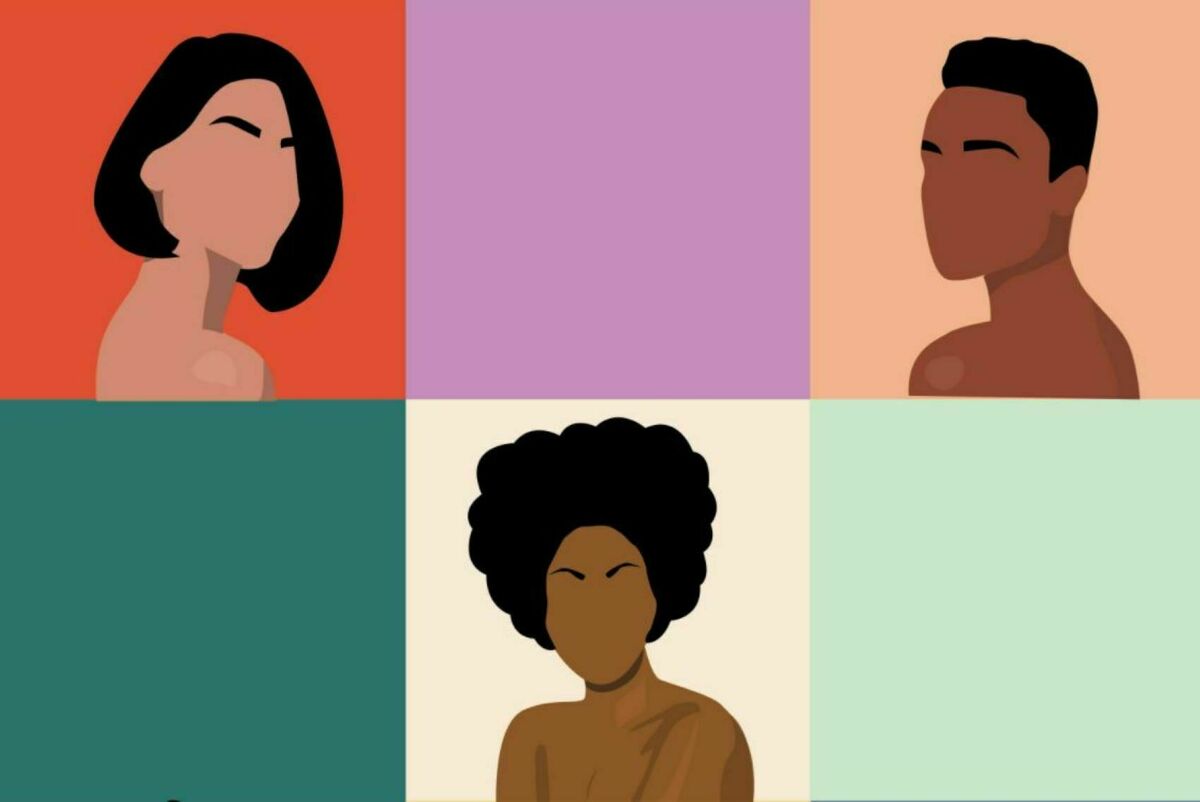When I was in graduate school, I remember reading an essay in which Jacques Derrida purports to “write as a woman.” I was in a gender studies program in a highly secular context, and we had a lively seminar on Derrida’s essay, eventually reaching the consensus that no, Jacques, you can’t simply step into a woman’s identity like you might step into a set of trousers. This was the mid-2000s, a different era, when the word “woman” still had some fleeting connection, however tenuous, to female embodiment.
Now, fifteen years later, we have reached a juncture where appropriating the identity of women is considered laudatory, liberating, the next frontier of civil rights—and raising cautions or questions is blasphemous. Increasingly, defining a woman as an adult human female is considered hate speech.
Perhaps you think I am exaggerating. Yet the most recent HR compliance training I completed for my employer directed me to cease using the phrase “pregnant woman” or the word “breastfeeding.” Such words are now considered discriminatory, and banishing them from one’s vocabulary is part of the standard package of workplace ethics.
I want to be clear that I am not critiquing individuals who experience gender dysphoria or who do not conform to cultural gender norms (in fact, my general position is that we should not rush to medicalize those individuals). What I am critiquing here is the dominant cultural framework that now filters and interprets those experiences. To be clear, not all trans-identified persons ascribe to the transactivist slogans. My beef is with the slogans.
Perhaps the most prominent activist slogan is this: “trans women are women”—a slogan now embraced by most mainstream feminist and civil rights organizations, like the ACLU. One cannot affirm that statement without denying that women are female. But if a woman is not an adult human female, what is she? Helen Joyce recently gave a rundown of female-free definitions of “woman” in an article:
Anyone who identifies as a woman
—Australian Academy of ScienceSomeone who “experiences the norms that are associated with women in her social context as relevant to her”
—Katharine Jenkins, British philosopherA useful shorthand for the entanglement of femininity and social status regardless of biology—not as an identity, but as the name for an imagined community that honors the female, enacts the feminine and exceeds the limitations of a sexist society.
—Susan Stryker, American transwoman writing in TIME Magazine
I will not take the time here to interrogate these definitions and their flaws (Joyce does). I will only say that I am not exactly sure if I would qualify as a woman on these terms. Depends on the day, I suppose. There is little agreement among these definitions, but one defining feature they share is the decisive decoupling of “woman” from “female.”
If “woman” no longer names the billions of humans who are female, how do we speak about them? The tactic du jour seems to be this: forget persons . . . let’s just talk about body parts and functions. A 2020 Tampax ad calls us to celebrate “people who bleed.” Last I checked, all people bleed, so perhaps next time Tampax should be more precise and say: “Let’s celebrate vagina-owners who bleed through their vaginas.”
But even mentioning some body parts, like breasts, has become verboten. Instead, we should say “chest-feeding,” because we should not refer to lactating mammary-gland havers who do not identify as women as having “breasts.” Thus, I am a bleeder, a chest-feeder, and my husband is an inseminator—which sounds like an X-rated comic book hero. Captain Inseminator.
There are numerous problems with this approach, but I will name just two: firstly, this is dehumanizing, in a very literal sense. This way of speaking reduces persons to mammalian parts and functions, like a menu in a butcher’s shop. Moreover, these disparate labels elide the glaring reality that these parts and functions tend to come arranged in a bundle—that inseminators are also testicle-havers, and gestaters are also menstruators and lactaters.
The most stunning aspect of this linguistic insurrection is the un-naming of female humans. As Helen Joyce puts it in her book, “the quest for the liberation of people with female bodies has arrived at an extraordinary position: they do not even constitute a group that merits a name.”
How did we get here? Ironically, feminism. For the past five decades, mainstream feminism has enthusiastically been sawing off the branch it is perched upon. While there are myriad iterations and definitions of feminism, a common denominator among them is ostensibly a serious concern with the status and wellbeing of women—and yet this very concept has been steadily emptied of content by feminists themselves.
This evacuation of the word “woman” is the result of a twofold revolution: a conceptual revolution via the coinage of “gender,” and a concurrent revolution in the material circumstances of women through the embrace of contraception. Although she never actually uses the term gender, the seed of contemporary gender theory can be found in Simone de Beauvoir’s The Second Sex: “one is not born, but rather becomes a woman.”
This statement, published in 1949, prefigures the turn toward the concept of “gender” that would begin in the following decade and take hold in the 1970s, largely through the work of psychologist John Money. Money argued that biological sex has no intrinsic connection to men and women’s social roles, psychologies, or behaviors. These he saw as products of culture, rather than nature, and he imported the term “gender” from linguistics to refer to them.
Money had the unfortunate opportunity to “test” his theory of social constructionism on a set of twin brothers, one of whom was disfigured by a botched circumcision and raised as a girl. Throughout these boys’ lives, Money published his theories widely, touting his experiment as a success. But it proved to be a catastrophic failure: both boys committed suicide as adults. This tragedy took decades to play out, however, and in the interim, Money’s concept of gender swept through the academy, becoming thoroughly entrenched in feminist theory and the social sciences.
This conceptual ascendency of “gender” coincides with the normalization and social acceptance of contraception—both of these upheavals accelerate rapidly in the late 1960s and 70s, achieving status quo status by the 1980s. This sets the scene for the theoretical work of Judith Butler, who in the late 80s and 90s expands the social construction of gender to include sex as well.
Butler ups the ante of social constructionism, asserting that biological sex itself is a social fabrication: “‘female’ no longer appears to be a stable notion; its meaning is as troubled and unfixed as ‘woman’” (from the preface to Gender Trouble). Butler leans into many of the ideas asserted by Simone de Beauvoir, taking them to new extremes. Near the end of The Second Sex, de Beauvoir proclaims, “nothing is natural.” For Butler, that statement is a foundational premise. The idea that humankind is characterized by two sexes that are biologically complementary is a social fiction rather than a matter of fact.
The key to comprehending Judith Butler is to grasp her reliance on the postmodern philosophy of Michel Foucault. I would argue that most inhabitants of the gender paradigm have unwittingly adopted a de facto Foucauldian worldview, inherited, at least in part, through trickle-down Judith Butler. Butler argues that what we perceive to be “real” is actually a fiction that is created and enforced by institutional power.
In this anti-realist perspective, truth is suspended in air quotes as ultimately unknowable (or non-existent). All that remains is power. Knowledge, then, is not a matter of discerning or recognizing what is true, because “truth” itself is a construction of power. This philosophical approach leads to a particular political approach: strategically using language to subvert existing categories and create the reality you want—which causes something of a paradox.
On the one hand, gender theory is fundamentally anti-realist: it rejects the idea that “sex” and “gender” (female, man, woman) name something real. Instead, those concepts are seen as linguistic power moves that create the illusion of something real.
And yet—we regularly hear, in activist rhetoric and on social media, emphatic claims about reality. “Trans women are women”; “sex is a spectrum”—those are statements that make clear assertions about what is real.
There is a reification turn happening here: to “reify” means to “make real.” The gender paradigm depends upon a radically constructivist, anti-realist view of reality in order to dismantle categories and create new ones—and then pivots to assert those new categories as actually, really true, as unquestionable absolutes.
Most people who inhabit the gender paradigm are not hardcore Butlerian anti-realists, at least not consciously. But they have unknowingly entered into a paradigm that is, at root, based in postmodern anti-realism. The latest iterations of gender have driven a wedge between body and identity, between “female” and “woman.” The initial feminist distinction between sex and gender has become an outright schism.
Through these radical changes in thought and practice, our procreative potential as sexed beings has receded entirely in our cultural imagination. We no longer think of “woman” and “man”—or increasingly, “male” and “female”—as grounded in procreative potential at all.
Why is this bad? Few sex-segregated spaces exist in Western liberal democracies. The ones that do—bathrooms, locker-rooms, prisons, shelters, and sports teams—exist for the benefit of women, who are more vulnerable to sexual assault and harassment. It is baffling to hear radical feminists like Catherine MacKinnon, who for decades has held a steady spotlight on women’s sexual exploitation, to suddenly pooh-pooh the idea that women might need separate facilities in certain circumstances. “Most bathrooms come with stalls and doors that shut,” she shrugged in a 2015 interview.
The only antidote to this collective amnesia is to reassert a definition of woman as an adult human female, the kind of human being whose body is organized according to the potential of generating life within herself. This philosophical category of “potentiality” includes women who are infertile, because the very definition of “infertile” signals an innate potential that is prevented from being actualized.
If feminism does not correct course and recouple “woman” with “female,” it will lose its entire raison d’etre—because a feminism that rejects a definition of woman grounded in the concrete reality of the sexed body cannot effectively advocate for those whose lives and circumstances are shaped by that reality.


